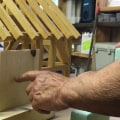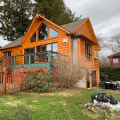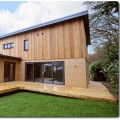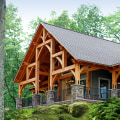In Denver, timber frame homes stand as enduring testaments to craftsmanship and tradition. Yet, even these sturdy structures are not immune to the challenges posed by water damage. When moisture infiltrates the heart of these wooden wonders, it threatens not just their structural integrity but also the very essence of their character. This article explores the intricate process of water damage restoration for Denver's timber frame homes.
What Are The Most Common Causes Of Water Damage In Denver's Timber Frame Homes
The most common causes of water damage in Denver's timber frame homes can stem from various sources, each posing a threat to the structural integrity and aesthetic appeal of these cherished properties.
Roof Leaks
Damaged or improperly installed roofing materials can allow water to seep into the attic and walls of timber frame homes, leading to moisture buildup and potential structural damage.
Plumbing Issues
Burst pipes, leaking faucets, and faulty plumbing fixtures are frequent culprits of water damage in timber frame homes. Even minor leaks can result in significant moisture intrusion over time.
Poor Drainage
Inadequate drainage around the foundation of a timber frame home can lead to water pooling, which may infiltrate the structure's wooden components and cause deterioration.
Flooding
Denver's unpredictable weather patterns, including heavy rains and snowmelt, can result in flooding around timber frame homes, particularly if they are located in low-lying areas or near bodies of water.
Condensation
High humidity levels and poor ventilation within timber frame homes can lead to condensation buildup on surfaces, promoting mold growth and wood rot over time.
Exterior Damage
Cracked or deteriorating siding, windows, and doors can allow water to penetrate the exterior envelope of timber frame homes, leading to moisture intrusion and subsequent damage.
Foundation Issues
Settlement or shifting of the foundation can compromise the structural integrity of timber frame homes, resulting in cracks that allow water to infiltrate the interior spaces.
Appliance Malfunctions
Malfunctioning appliances such as dishwashers, washing machines, and water heaters can leak water, posing a risk of damage to timber frame homes if not promptly addressed.
Understanding these common causes of water damage is crucial for Denver homeowners, as it allows them to take proactive measures to prevent moisture intrusion and protect the structural integrity of their timber frame homes for years to come.
Why Is It Important To Address Water Damage In Denver's Timber Frame Homes As Soon As Possible
Addressing water damage in Denver's timber frame homes as soon as possible is paramount for several reasons, each underscoring the urgency and importance of prompt action.
Prevention Of Further Damage
Water damage can exacerbate quickly, leading to structural deterioration, mold growth, and other costly issues if left unaddressed. Prompt intervention can mitigate further damage and prevent the need for more extensive repairs in the future.
Preservation Of Structural Integrity
Timber frame homes rely on the strength and integrity of their wooden components. Water infiltration can weaken the wood, compromising the structural stability of the home over time. Addressing water damage promptly helps preserve the structural integrity of the timber frame, ensuring the home remains safe and sound for years to come.
Mitigation Of Mold Growth
Moisture from water damage creates an ideal environment for mold growth, which can spread rapidly throughout a timber frame home. Mold not only damages wood and other building materials but also poses health risks to occupants. By addressing water damage quickly, homeowners can prevent or minimize mold growth and protect the health of their families.
Prevention Of Costly Repairs
Delaying water damage repairs can lead to more extensive damage and costly repairs down the line. By addressing water damage promptly, homeowners can mitigate the need for costly repairs and potentially save thousands of dollars in restoration expenses.
Preservation Of Property Value
Water damage can significantly diminish the value of a timber frame home, making it more difficult to sell in the future. By addressing water damage promptly and restoring the home to its pre-damaged condition, homeowners can preserve the property's value and protect their investment.
Minimization Of Disruption
Water damage can disrupt daily life and render parts of the home uninhabitable during the restoration process. By addressing water damage quickly, homeowners can minimize disruption to their lives and expedite the restoration process, allowing them to return to normalcy as soon as possible.
Make sure to choose a reputable restoration company like RestoreCo in Denver, CO, to address water damage in timber frame homes. With their expertise, professionalism, and prompt response, RestoreCo can efficiently assess, mitigate, and repair water damage, ensuring the preservation of your home's structural integrity and minimizing further risks.
How To Choose A Restoration Company In Denver That Specializes In Water Damage Restoration For Timber Frame Homes
When selecting a restoration company in Denver specializing in water damage restoration for timber frame homes, several key considerations can help homeowners make an informed decision.
Firstly, it's essential to research and identify restoration companies with expertise specifically in water damage restoration for timber frame structures. Look for companies with a proven track record of successfully restoring timber frame homes and inquire about their experience and credentials in this specialized area.
Additionally, seek recommendations from trusted sources, such as friends, family, or local community forums, to narrow down potential restoration companies. Once you've compiled a list of candidates, schedule consultations with each company to discuss your restoration needs, evaluate their approach to water damage restoration for timber frame homes, and request a detailed estimate for the project.
During these consultations, pay attention to the company's communication style, professionalism, and willingness to address your concerns. Finally, don't hesitate to ask for references or testimonials from previous clients to gauge the quality of their work and customer satisfaction.
What Is The Process Involved In Water Damage Restoration For Timber Frame Homes In Denver
The process involved in water damage restoration for timber frame homes in Denver is a comprehensive and multi-step endeavor aimed at mitigating damage, preserving structural integrity, and restoring the home to its pre-damaged condition. Here's an overview of the typical restoration process.
Assessment And Inspection
Restoration professionals begin by conducting a thorough assessment and inspection of the water-damaged areas. This involves identifying the source of the water damage, evaluating the extent of the damage, and assessing the structural integrity of the timber frame.
Water Extraction
The next step is to remove standing water from the home using specialized equipment such as pumps, wet vacuums, and dehumidifiers. This helps prevent further damage and moisture buildup.
Drying And Dehumidification
Once the standing water has been removed, restoration professionals employ drying and dehumidification techniques to thoroughly dry out the affected areas. This may involve using air movers, dehumidifiers, and moisture meters to ensure that all moisture is properly eliminated.
Cleaning And Sanitizing
After the drying process is complete, restoration professionals clean and sanitize the affected areas to remove any dirt, debris, or contaminants left behind by the water damage. This helps prevent mold growth and ensures the home is safe and sanitary for occupants.
Structural Repairs
Depending on the extent of the water damage, structural repairs may be necessary to restore the integrity of the timber frame. This may involve repairing or replacing damaged beams, studs, or other structural components.
Surface Restoration
Restoration professionals then focus on restoring the surfaces of the home, including walls, ceilings, and floors. This may involve repairing or replacing damaged drywall, insulation, flooring materials, and other finishes.
Mold Remediation
If mold growth is present as a result of the water damage, restoration professionals will conduct mold remediation to safely remove and eliminate mold from the home. This typically involves containment, removal, and thorough cleaning of affected areas.
Final Inspection And Restoration
Once the restoration work is complete, a final inspection is conducted to ensure that all repairs have been completed to the highest standards. Any remaining touch-ups or finishing touches are made to restore the home to its pre-damaged condition.
Throughout the water damage restoration process for timber frame homes in Denver, restoration professionals work diligently to ensure that the home is thoroughly cleaned, dried, repaired, and restored to its original state.
Contact A Restoration Company In Denver
Water damage restoration for timber frame homes is a complex and critical process that requires expertise, precision, and a deep understanding of the unique challenges posed by water infiltration in wooden structures. Through meticulous assessment, efficient water extraction, thorough drying and dehumidification, and expert repairs, restoration professionals work tirelessly to mitigate damage and preserve the structural integrity and beauty of timber frame homes.
If you're in Denver, RestoreCo stands as your trusted ally in the endeavor to address water damage in timber frame homes. With their expertise, dedication, and commitment to excellence, they bring tailored solutions to restore the integrity and beauty of your cherished property. Contact them to learn more.




Leave a Comment